Gluten-Free Crusty Boule
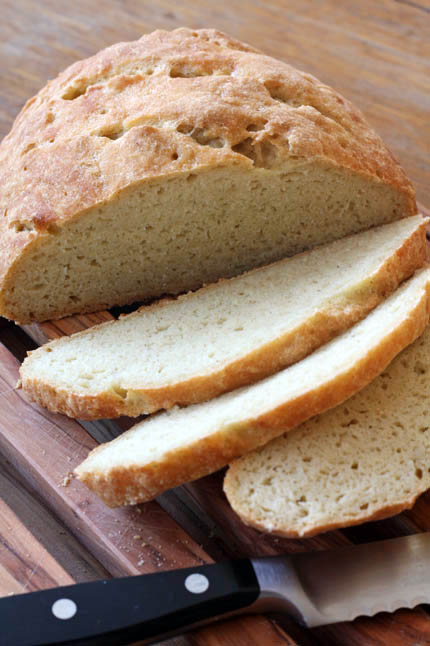
Gluten-free breads were a major request from readers of Artisan Bread in Five Minutes a Day. The options for buying gluten-free bread are both unsatisfying and expensive. So here is a wonderful bread that anyone, celiac or not, would want to eat.
Several readers have asked about the olive oil dough on page 302 of The New Healthy Bread in Five Minutes a Day. While the Crusty Boule (page 299 in the book) has a chewy and toothsome texture, the bread made with the olive oil dough has a much lighter, almost fluffy interior. Replace the neutral flavored oil in the Gluten-Free Crusty Boule recipe with olive oil if you prefer the texture of that loaf. They are both wonderful and give you fantastic options for free form loaves, sandwich breads, pizzas and even crackers. You will find all of these, plus many other gluten-free breads and awesome sticky buns in the book, with the link above.
For those of you who are celiac or just baking for someone who is you will find all of the directions and tips for handling gluten-free dough below. It is just as easy as the other recipes, but requires slightly different techniques and a new list of ingredients.
Gluten-Free Crusty Boule
Makes enough dough for at least four 1-pound loaves
2 cups Brown Rice Flour
1 1/2 cups Sorghum Flour
3 cups Tapioca Flour (also called tapioca starch)
2 tablespoons yeast (can be reduced but you will have to increase the rise time)
1 tablespoon kosher salt (increase or decrease to taste)
2 tablespoons Xanthan Gum
2 2/3 cups lukewarm water
4 large eggs, whisked together
1/3 cup neutral-flavored oil or olive oil
2 tablespoons honey or sugar
Click here to see the video of this recipe

Mixing and storing the dough: Whisk together the flours, yeast, salt and xanthan gum in a 5-quart lidded Round Food Storage Container. Combine the oil, honey and water, set aside.
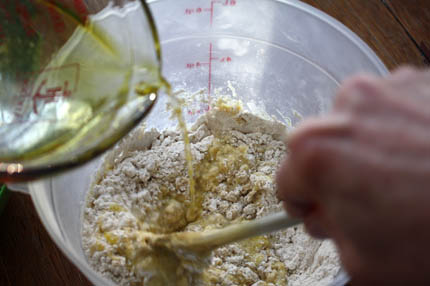
Dump the eggs into the dry ingredients and then stir while you pour in about 1/3 of the oil and water. Unlike my wheat doughs, do not add all of the liquid at once and stir. If you do, that will result in a lumpy dough.
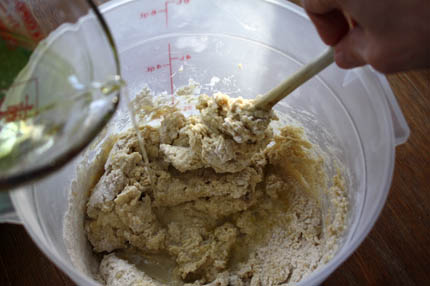
Continue to stir while you pour in another 1/3 of the liquid.
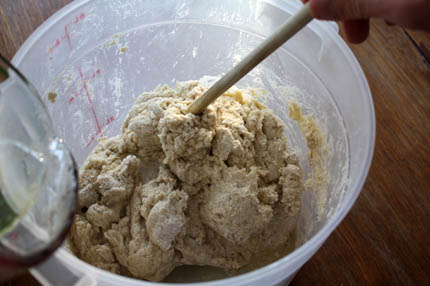
The dough will start to come together in a thick dough. Add the final 1/3 of liquid and
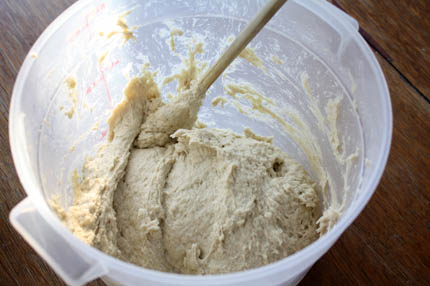
Stir until the dough is smooth. Cover with the lid, but do not snap it shut. Allow it to rest on the counter for about 2 hours. Place the dough in the refrigerator and store for up to 7 days. (I have a piece in the freezer and I will report back about how that turns out once I defrost it and bake it up. Stay tuned.)

On baking day take the bucket from the refrigerator. The dough will be quite fluffy still and you want to try not to handle the dough too much. Just like our other doughs the trick is to keep as much of the air bubbles in tact as possible.
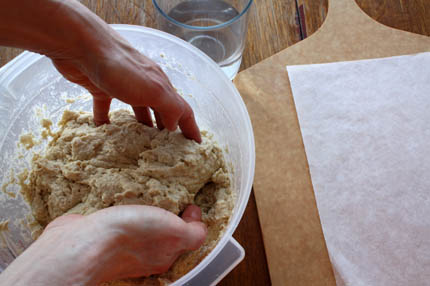
Use wet hands to remove 1-pound (grapefruit-size) piece of dough from the bucket.
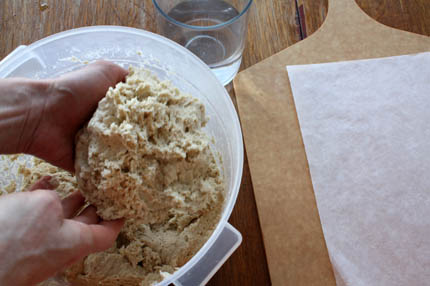
The dough will be quite scraggly when you take it out, just place it on a piece of parchment paper.
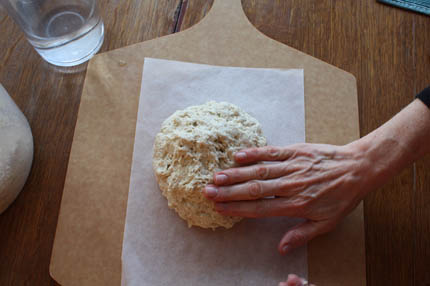
Use wet hands to smooth out the surface of the dough.
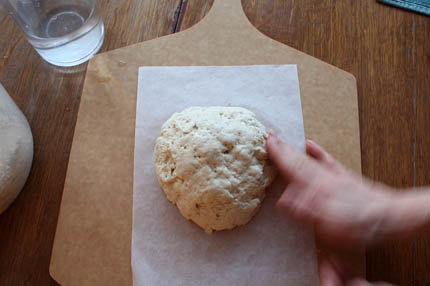
This may take dipping your hands in the water a few times…

to get a nice shape.
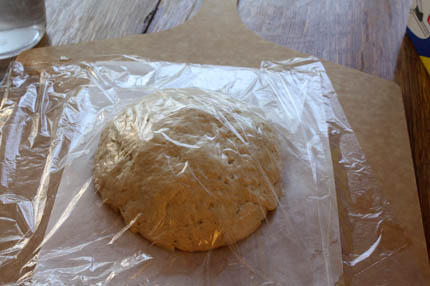
Cover loosely with plastic wrap and allow to rest on the counter for about 90 minutes. If your kitchen is very warm you may only need about 75 minutes.
30 minutes before baking time preheat the oven with a 5 1/2 quart Dutch Oven in it to 500 degrees. Be sure it is fitted with a metal Replacement Knob
, the original plastic knobs can only be heated to about 400 degrees. To find directions for baking on a stone see page 237 of HBin5.
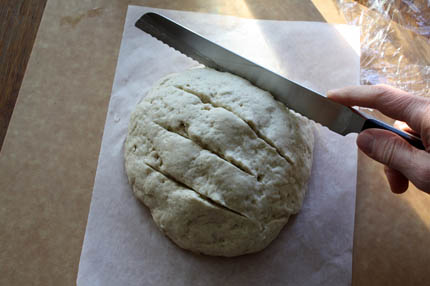
The dough will not have grown much while resting, but it will seem a little bit puffier. Use a serrated knife to cut slashes in the dough.
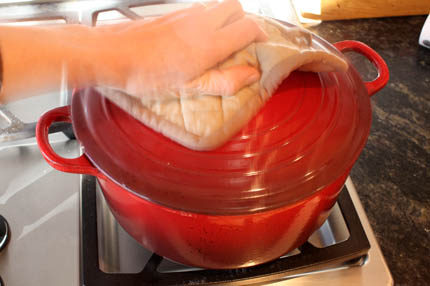
Remove the pot from the oven and take off the lid.

Lift the bread on the parchment and VERY CAREFULLY lower the parchment and bread into the pot, replace the lid onto the pot. Return to the oven and bake for 20 minutes. After the 20 minutes remove the lid, turn the heat down to 450 and bake for an additional 15 minutes.

Once the bread is done baking remove it from the pot using a spatula.
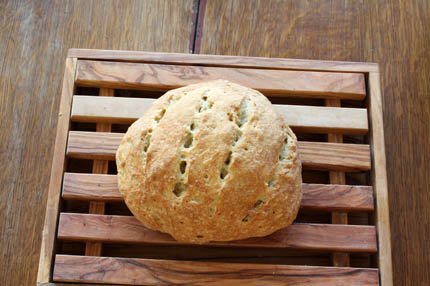
Allow the bread to cool completely before eating or the center may seem gummy.
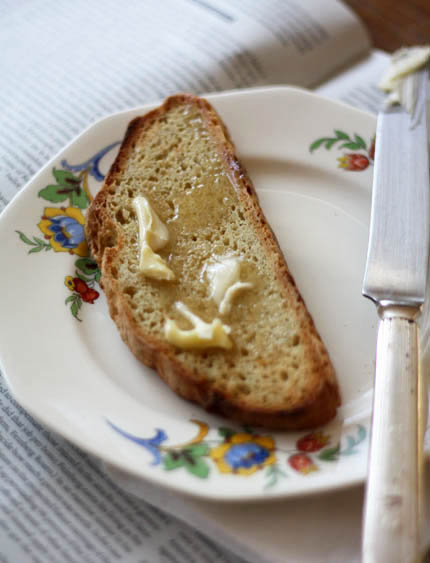
WEIGHTS for GLUTEN-FREE FLOURS
Brown Rice Flour: 1 cup = 5 1/2 oz = 155 grams
Tapioca Flour (Starch): 1 cup = 4 1/2 oz = 130 grams
Sorghum Flour: 1 cup = 4 3/4 oz = 135 grams
Cornstarch: 1 cup = 4 1/2 oz = 130 grams
Note: BreadIn5.com is reader supported. When you buy through links on the site, BreadIn5 LLC earns commissions.
Thanks. I Just bought both of your books. I’m very excited. I’ve been making your five minute bread for many many years. What makes you guys now use a mixer rather than the bucket. I’ve always used
The mixer works better for gluten-free (better emulsification of the ingredients, with better resulting crumb-texture), but it’s not absolutely required. For wheat-based flours, they both work equally well but the mixer saves on elbow grease!
Good morning
I am a little confused. I have made the above recipe and it has turned out wonderful.
Now I bought the gluten-free book and I’m page 64 I thought the recipe would match what was above. The recipe on page 64 omits the eggs. Why are there two different recipes for the same type of bread? Or am I reading it wrong Thanks
Because so many of our readers with gluten and wheat sensitivity also reported trouble with eggs, I made the default recipe in the published book egg free. See page 73 for the version with eggs or egg whites.
Good morning. Page 73 talks about lazy sourdough shortcut.
Look down that page, below the gray-shaded box, to the section that starts “VARIATION: FREE-FORM LOAF WITH EGGS OR EGG WHITES FOR EXTRA RISE.” It continues on the next page.
Good morning. I just tried making the challah bread. It was a disaster. I could not roll the balls very well and then I rolled them into logs and could not lift them to braid them they fell apart. What advice can you give me?
Sounds like the dough was too wet, and maybe not fully emulsified/mixed. I found that the gluten-free works much better if you use the stand mixer, so that’s the first thing to try next time. Second did you use exactly the products recommended in the recipes? These were all tested with Bob’s Red Mill flours, and substitutions will require significant water adjustments, in directions that can’t be predicted. Finally you can salvage the dough, most likely by adding flour mixture to it, letting it sit on the counter for 2 hours to ferment, refrigerating, and starting again. No promises though…
Hi Jeff I did use a stand mixer. I agree with you it is definitely the better way for the gluten-free dough. I have been using Bob’s red mill 1:1 flour for everything that I’ve been making gluten-free. I used the rest of the dough for brioche bread and that worked fine.
So I’m not really sure what to do different this time? thanks
I think that’s the problem. The 1:1 flour from Bob’s Red Mill failed spectacularly in tests. So the books’ GF recipes use a custom flour mixture, based on a variety of Bob’s Red Mill flours, but not their 1:1 mixture.
Hi Jeff it’s me again lol
I bought bob red mill flowers this time and try the Challah bread again. It was much easier to braid but didn’t rise very much. My question is with gluten-free Challa bread will it rise and look like a regular one?
Also I’ve tried asking this question before but not successfully. The recipe above this question and answer section calls for brown rice flour and tapioca flour to make a boule. The Boule recipe in the book has a master recipe that starts with white rice flour and Potato starch and other ingredients. I am trying to figure out why they are different recipes. Thank you so much with your patience with me and always answering. I really appreciate it
Not quite–see the color photo insert that starts after page 228 in Gluten-Free Artisan Bread in Five Minutes a Day (on Amazon at https://amzn.to/3ntsS4X). It’s flatter, and the braids aren’t as well-defined as in wheat-based challah. 2nd question: The website’s recipe is from 2010. Cookbook authors are constantly refining recipes, and in this case, making them more appropriate for a book (in 2015!)–it was a judgement call–experiment and make whichever you prefer. Note the the book calls for creating a large amount of flour-mixture. Another key difference is that the book’s recipe doesn’t call for eggs in its default version, because people had written in on the website that they were also sensitive to eggs.
Good morning.
Now I understand about the challah bread. Unfortunately for me we like to make French toast with it so needing height is important.
I’m sorry that you did not go with the above recipe in your book. The recipe above is absolutely amazing. Can I use that as my mixture flour (replacement for pg 60) that is called for in other recipes?
Thanks
Sure! And re: challa just bake in a loaf pan… Sizing will be key
Bonjour,
Voilà je suis diabétique Type 1 sous insuline et je prends une alimentation IG bas.
Je n’ai pas droit à la farine de riz, blanche ou brune, pourriez-vous me conseiller, mon soucis c’est que j’aime les pains noires Allemand, Comment faire pour avoir des farines foncées en sans gluten ? Grosse question !!!
Merci pour tout conseil de votre part.
Cordialement
Bosha, my French is weak, so you’ll have to use Google Translate like I just did. About the diabetes and glycemic index–the truth is that all our recipes are based on carbohydrate-rich flours, whether wheat-based or gluten-free. The glycemic index is slightly better with whole grains, but you need to limit even these if you have diabetes. My gluten-free book (https://amzn.to/3NSJCNM) has recipes using white flours (best avoided given what you’ve told me), but also some whole grains (not as much). You can make dark breads with my flour mixture #2 in that book. I never developed a German-style black bread for GF, so this would take some experimentation.
Thank you for your quick response. I will therefore follow your advice and do several tests depending on the result, Regards
I wish you had put the corrected weights and ingredients in the body of the recipe, rather than at the end. I just made a half recipe of the dough and wondered why the texture seemed all off. ny way to save it or should I just throw it out? (I’ve made the basic recipe successfully and was looking forward to trying the boule.)
Yes, just add in the flours where your calculation shows that you undershot the target weight. Which of my books do you have? I may be able to direct you to some tips in there that might help.
Thanks for your response. After I got over my initial frustration I refrigerated the dough and baked it this morning and it tastes great – may not be the perfect boule, but still wonderful gluten free bread. Your books and recipes are a real gift.
Terrific, glad it worked out.
Is there an egg replacement for your gluten free breads?
Thank You!
There might be, but not tested by me. I would be skeptical as to whether it would work because natural eggs have a leavening effect that I don’t think you’re going to get with a substitute.
Can I replace the corn starch with something else?
Unfortunately, the swaps are limited. The ones that I found that actually worked are in my gluten-free book (https://artisanbreadinfive.com/gf), or here on the website (https://artisanbreadinfive.com/2014/10/19/substitutions-for-ingredients-in-our-gluten-free-recipes/). You can try proportionally increasing the other ingredients, or trying other gluten-free flours and starches– but this’ll be an experiment– one in which I myself was unsuccessful in eliminating corn starch.
I’m going over the corrections and there are conflicting measurements between the correction in the first Healthy Bread says—-
“Page 268, Ingredients list for Gluten-Free Master Recipe: The metric weight of brown rice flour should read 155 grams, not 160.”
The recipe on this page says—-
“WEIGHTS for GLUTEN-FREE FLOURS
Brown Rice Flour: 1 cup = 5 1/2 oz = 160 grams”
Which is correct and do you have the most updated weight measurements chart available on your website or if you can tell me where to access it. Thanks!
What you’re referencing (the weight of brown rice flour) is on page 268 of The New Artisan Bread in Five Minutes a Day, not my first Healthy Bread in Five Minutes a Day book. So, I assume you’re working from the NABi5 book. The correct weight is 155 grams, and I’ve corrected inconsistencies here on my website. That said, we’re talking about 0.176 ounces, which isn’t going to be particularly important. Much more important is that this weight is for Bob’s Red Mill brown rice flour, and I can’t vouch for other brands–if you swap, you’ll have to re-test the recipes and do your own experimentation. Also, I assume you’ve seen the correction about the missing sorghum flour in the first printings of the book (see https://artisanbreadinfive.com/2013/10/01/corrections-to-first-printing-of-the-new-artisan-bread-in-five-minutes-a-day-2013/). If the ingredient lists on page 268 and 275 of your copy include sorghum flour, you have a later-published copy that has that part corrected. The most useful weight-defined recipes for GF bread are in Gluten-Free Artisan Bread in Five Minutes a Day (https://amzn.to/3NSJCNM). My publisher will stop speaking to me if I put all the content from my books here on the website!